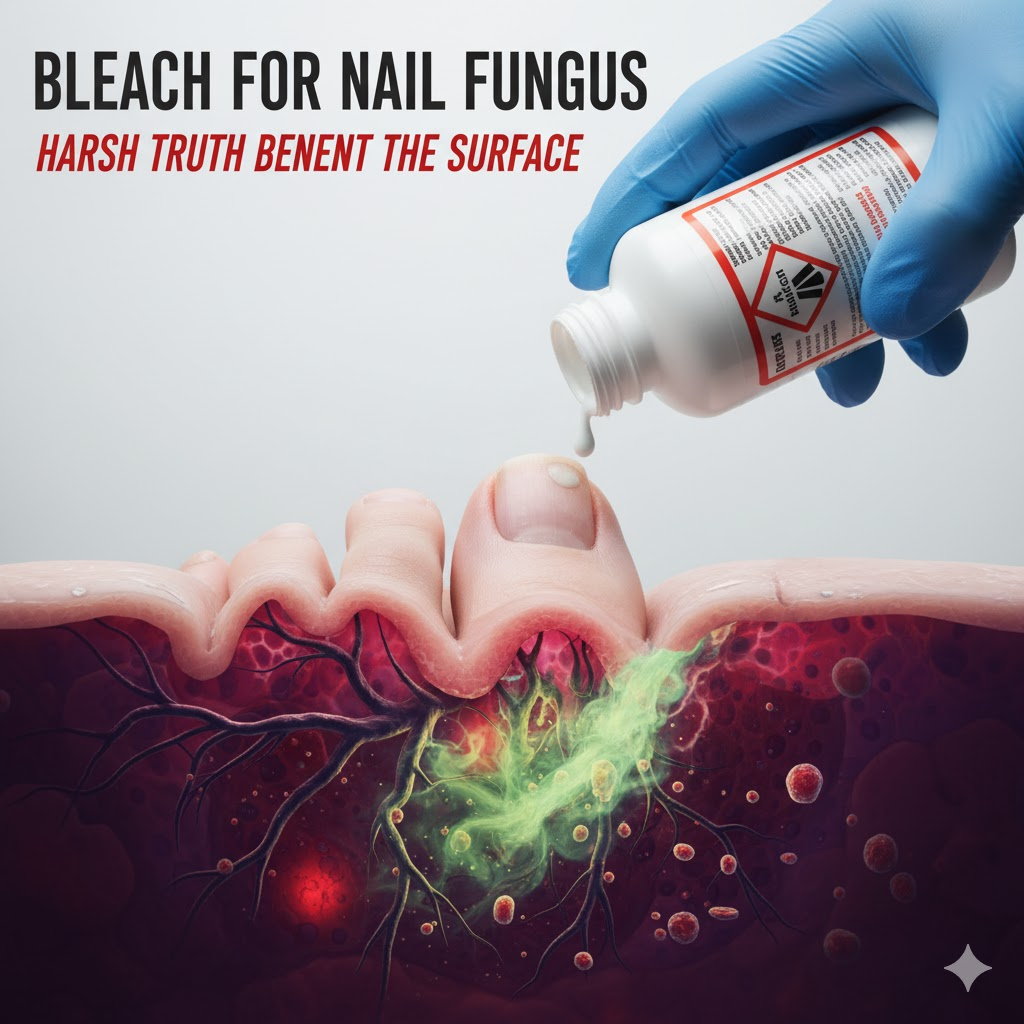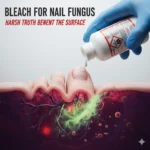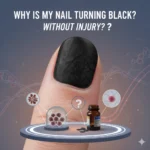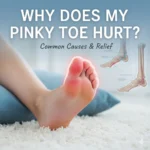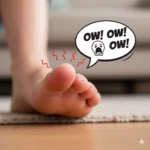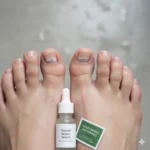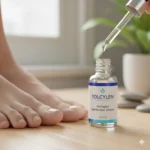Let’s be honest for a second. You might look at your yellow, thick toenail and think, bleach can make it better. It’s cheap. It’s strong. It cleans everything else, right?
So why not nails?
That’s where this story begins. With good intentions and a bottle of Clorox.
But here’s the thing. Nail fungus isn’t a stain. It’s a living, breathing infection buried deep inside your nail bed. It’s stubborn. It hides. And bleach—yeah, that same bleach that whitens your bathroom tiles—doesn’t play nice with skin.
Let’s peel back the layers.
What Exactly Is Nail Fungus?
Doctors call it onychomycosis. Sounds fancy. Feels awful.
It’s a fungal infection that eats away at the keratin—the hard stuff that makes up your nails. It starts small, a yellow dot near the edge. Then it spreads. Slow. Quiet. Until the whole nail turns thick, crumbly, and gross.
And it doesn’t care who you are.
Fungi love dark, warm, damp spaces. Your shoes? Perfect.
The American Academy of Dermatology says near 1 in 10 people will deal with it at some point. Older adults? Closer to 1 in 4.
And once it starts, it doesn’t go away. You can’t scrub it off. You can’t wish it away. It grows under the nail, in places you can’t reach.
That’s why bleach feels like a tempting shortcut.
Why People Try Bleach on Nail Fungus
Because it feels logical.
Bleach kills germs. Fungi are germs. So… bleach must kill fungus, right?
People soak their feet in diluted bleach water. Some even dab it straight on the nail. Others mix it with vinegar or baking soda. There are dozens of DIY recipes online.
It’s desperation disguised as creativity.
You can almost hear the thought process: If it burns a little, it’s working.
But that’s the trap.
What Experts Actually Say
Cleveland Clinic doctors are clear—don’t use bleach on your skin or nails. It’s not safe. It’s not proven. It can cause chemical burns, blisters, and permanent nail damage.
Bleach doesn’t reach deep enough into the nail bed to kill the fungus living underneath. It might lighten the surface. Make things look cleaner for a bit. But it doesn’t fix the problem.
It’s like painting over rust.
Doctors give special medicine that goes inside your nail and kills the fungus. Bleach? It sits on top, angry and useless.
Dr. Shari Lipner says bleach can kill fungus in a lab dish, not in your toenail.. You’ll hurt yourself before you help yourself.”
So yeah. Science says no.
What Actually Happens When You Use Bleach
Let’s talk about it—the burn.
Most people describe it as a strong sting at first. Then redness. Then peeling. Sometimes even swelling. The nail turns brittle, the surrounding skin cracks. It feels clean, sure. But it’s damage disguised as progress.
Bleach breaks down proteins. Your nails are proteins.
You see the problem now?
When it eats away at the keratin, it leaves the nail weaker, thinner. The fungus finds that opening and digs in deeper. So while you think you’re fighting it, you’re actually helping it.
Yeah. Ironic.
The Safer Alternatives (That Actually Work)
Let’s be practical. You want that fungus gone.
Here’s what experts actually recommend:
1. Antifungal Topical Treatments
Over-the-counter creams and medicated nail lacquers help mild cases. Medicines like clotrimazole, terbinafine, and ciclopirox stop the fungus from growing. It takes patience. Months. But it’s safe.
2. Oral Antifungal Medication
For deep infections, doctors prescribe pills like Lamisil (terbinafine) or Itraconazole (Sporanox). They target fungus through your bloodstream. You’ll need blood tests to check liver health. But they’re effective.
3. Laser Therapy
High-tech and pricey, but it works. Laser light penetrates the nail and destroys fungus without harming skin. A few sessions, and you can see new, healthy nail growth.
4. Home Remedies (The Safe Kind)
If you’re still drawn to natural stuff, try tea tree oil or vinegar soaks. They’re antifungal, gentle, and don’t burn holes in your skin. Add a few drops of tea tree oil in warm water. Soak for 15 minutes. Dry your feet completely.
Consistency is everything.
Why Bleach Myths Keep Spreading
Because people want fast results.
The internet has many pictures and stories saying, “I used bleach for a week, and my nail looks better! But what they don’t show is what happens later—the pain, the infection, the nail that falls off months after.
It’s like hearing only half the story.
And here’s the thing. Fungus is slow. It grows in months, dies in months. Nothing changes overnight.
So when people want fast fixes, they can get sad or even hurt.
The Science Behind Why Bleach Doesn’t Work
Bleach (sodium hypochlorite) is great on surfaces. It kills bacteria, mold, and mildew by breaking down cell walls. But the human body isn’t a countertop.
Your nail isn’t flat tile—it’s porous, layered, alive. Bleach can’t soak deep enough to reach where fungus hides, under the nail plate.
Think of it like rain hitting a roof. It cleans the surface, but doesn’t touch what’s in the basement.
To real kill fungus, you need something that goes deep and is make for it. Medicine from the doctor does that.. Bleach burns what it touches.
What Real People Have Experienced
Online forums are full of stories.
Some say bleach “worked” for a few weeks. Their nail looked better, cleaner. But then it came back worse. Pain. Swelling. The nail falling off entire.
Others describe white patches turning black. A sign of necrosis—dead tissue.
A few even ended up in the ER.
One user on Reddit wrote, “I soaked my toes in bleach for 10 minutes. The next morning, my skin peeled off like paper.”
That’s not treatment. That’s trauma.
What You Can Do Instead
If you’re reading this and already tried bleach—stop. Don’t panic.
Rinse your feet well with cool water. Apply a gentle moisturizer or aloe. Keep the area clean.
Then make an appointment with a dermatologist or podiatrist. They’ve seen worse. Trust me.
They might trim the nail, send a sample for lab testing, and prescribe the right antifungal. You’ll get a real plan. One that works.
And in the meantime—keep your feet dry, wear breathable shoes, change socks daily. Fungus loves moisture. Starve it.
Preventing Nail Fungus (The Smart Way)
It’s easier to stop it than to fix it. Here’s how:
-
Keep nails short and clean.
-
Dry feet full after showers.
-
Don’t walk barefoot in locker rooms or pools.
-
Rotate shoes. Let them air out.
-
Disinfect nail tools.
-
Don’t share socks, shoes, or clippers.
And most of all, don’t ignore early signs. A small yellow spot today becomes a full-blown infection tomorrow.
The Psychology of DIY Remedies
Let’s get real for a second. They use it because they’re frustrated.
Nail fungus takes forever to heal. Doctors say six months. a year. That’s torture when you want clean nails again.
So you go hunting for faster answers. Something you can do at home. Something that feels like action.
It’s human. It’s hope mixed with impatience.
But your body deserves better than guesswork.
Conclusion: Don’t Bleach Your Nails, Heal Them
Bleach can clean a floor. It can’t cure an infection.
Nail fungus is a medical problem, not a cleaning job. It needs care, not chemicals.
If you’ve been hiding your nails, embarrassed, you’re not alone. Millions struggle with this. But healing takes time—and the right treatment.
See a doctor. Be patient. Let the nail grow out clean, layer by layer.
Because your nails deserve a comeback story. Not a chemical burn.
FAQs: Bleach for Nail Fungus
1. Can bleach kill toenail fungus?
No. It kills fungus on surfaces but not under nails. It can cause burns and make things worse.
2. What happens if I soak my feet in bleach water?
Your skin may burn, peel, or blister. It doesn’t cure the fungus.
3. Can I mix bleach with vinegar for nail fungus?
Never. Mixing them releases toxic gas that can harm your lungs.
4. Is bleach safe for any kind of nail treatment?
No. It’s meant for cleaning surfaces, not the body.
5. What’s the safest home remedy for nail fungus?
Tea tree oil, apple cider vinegar, or over-the-counter antifungal creams.
6. How long does it take to cure nail fungus?
It can take 6–12 months, depending on severity and treatment type.
7. What does a fungal nail infection look like?
Thick, yellow, brittle nails with white spots or bad odor.
8. When should I see a doctor?
If your nail is painful, discolored, or separating from the nail bed.
9. Can bleach cause permanent damage?
Yes. It can destroy nail tissue and cause scarring.
10. What’s the best way to prevent nail fungus?
Keep feet dry, avoid tight shoes, disinfect tools, and wear flip-flops in public showers

